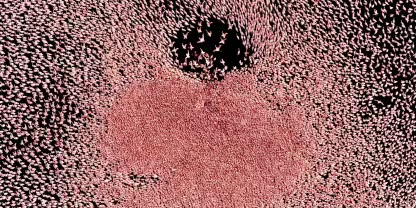Average Expert Rating
Rating Breakdown
Write a User ReviewThe Flamingos’ Holiday Home
The worth of this small reserve depends almost entirely on one factor – the number of flamingos gathered there. I have visited it twice when there were few flamingos around, and it was pretty underwhelming, with livestock being more numerous than wildlife, though the lovely setting at the base of the Rift Escarpment provided some compensation, as did the trio of primeval geysers that erupt in a searing sulphuric haze to feed a network of multihued channels on the western shore. But when the million-strong flamingo flocks associated with Nakuru relocate here, it makes for a spectacular sight, whether viewed up close from the lakeshore, or panoramically from the cliffs that rise to the immediate west.
Lake Bogoria: The Flamingo’s New Home?
The massed flocks of greater and lesser flamingos – up to two million in a good year – for years made this one of the best lakes in the Rift Valley to see one of Kenya’s most memorable spectacles. Honking in the shallows and all but concealing the alkaline lake’s waters, the flamingos for the most part stuck close to the shoreline of this 34km-long lake. At the time of writing the number of flamingos was fluctuating greatly from one year to the next. Check with your safari operator or another local source before making a visit here. If the flamingos are indeed present in large numbers, it really is a sight to behold and should on no account be missed. On the other hand, if the flamingos aren’t present, there’s very little reason to visit: thanks to growing human and livestock encroachment into the reserve, you’d be lucky to see zebra, impala or warthog, if indeed you see anything at all. The western shore is also home to hot springs and the largest number of geysers of any lake in Africa.
Geysers, Hot Springs and Clouds of Flamingos
Lake Bogoria feels truly wild and otherworldly. When I visited, there was no one else in sight. It’s rapidly growing in popularity, though, as this has been one of the best places in Kenya to see flamingos in recent years. Estimates suggest that flocks of up to 1.7 million birds were congregating here, especially during the European winter, when migrants gathered, creating a shimmering canvas of pink. Numbers have since fallen as some flamingos return to Lake Nakuru. Few other species tolerate the lake’s inhospitable conditions, but ostriches are sometimes seen on the shore.
Fiercely alkaline, the lake is visually dramatic even when the flamingos are out of range, edged as it is with dark, volcanic rock. Natural hot springs steam and bubble on the western side.
Flamingos and Pelicans in Lake Bogoria
As the name suggests, Lake Bogoria National Reserve, located in the Rift Valley, is centered around Lake Bogoria. The only road in the reserve follows the shore of the saline, alkaline lake famous for its vibrant pink flocks of flamingos that feed on the abundant algae. The reserve is also known for its geothermal activity, featuring hot springs and geysers that emit steam and mineral-rich waters.
As is the case with all the Rift Valley lakes, the number of flamingos fluctuates depending on water levels and algae availability. Flamingos aside, I’ve found the park very productive for waterbirds in general and watching big groups of pelicans fishing together has been a highlight for me.
Sometimes Pink-Tinged Lakeshore
When I visited in 2008 the park lived up to the hype with huge numbers of flamingos present. However, on my most recent visit things were very different indeed. In the two years leading up to this visit there had been a lot of rain, and water levels in Lake Bogoria (and in the beautiful neighbouring Lake Baringo) had risen considerably. The rising waters had drowned the hot springs and geysers, flooded the surrounding areas and the deeper waters had caused the flamingos to flee to waters more inviting. There were maybe 50 flamingos
Read more
present in the park, possibly fewer. In addition to that the only other animals visible were the goats belonging to local villagers who had pretty much moved into the park. To make matters worse, the local council, which must surely have been aware of the complete lack of wildlife and the general dire state of the park, had taken the bizarre step of doubling the cost of entry for tourists!However, don’t dismiss Lake Bogoria completely. Lake levels were slowly starting to fall and with luck the flamingos will start to return and the local council will get to work making the park a worthwhile destination.
Flamingo Heaven
The hordes of flamingos that once inhabited the shallow waters of Lake Nakuru NP left sometime ago for another nearby lake, Lake Bogoria – although the situation can change and many have now returned to Lake Nakuru. I was stunned by the sheer numbers of these beautiful creatures wading delicately in the shallows of the picturesque lake, itself dwarfed by some humongous Rift Valley mountains. The flamingos form patterns of pink and white (greater and lesser flamingo are slightly different colours) on the blue-green lake waters and it reminded me of ice skaters creating complex, rhythmic and graceful patterns on the ice. It was a remote spot but I am glad I made the effort to come – I will long remember these magnificent birds.
If you manage to drag your attention away from the flamingos covering the lake waters, you may also spot warthog, dik-dik, impala and Grant’s gazelle lurking in the scrubby landscape. The drive in is rough, bouncy and dusty, but this really is a unique experience.

